How to back up your Mac
Backing up your new Mac device is the smartest choice you can think of. Although Macs are not prone to failure, accidents can happen at any time. Therefore, you should back up your Mac regularly or set the machine to backup automatically.
There are many ways to do this. However, the most trustworthy and efficient method is to use Apple's own Time Machine tool.
Method 1 – Using Time Machine
You can use Time Machine to securely back up your Mac to an external drive. This also gives you the option to schedule automatic updates for your device.
Note – Time Machine formats the external device before setting it as a backup drive. Therefore, if it contains some important files, you should back them up to another drive.
Step 1 –On your Mac, click the “Apple” icon and then click “System Settings” to open it.
[If you are using an older version before macOS Ventura, you must click on the "Apple" logo and then click on "System Preferences" to execute Same operation]

Step 2 –Now, click on “Time Machine”.
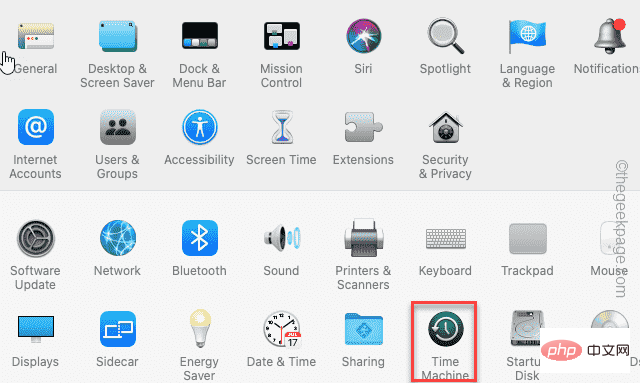
Step 3 –On the next page of Time Machine, you can select the device driver from the wizard.
Step 4 –After that, click on “Use Disk” to use that disk*.
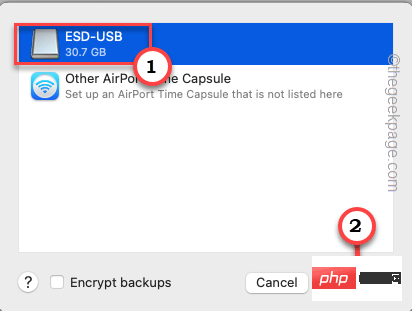
After this, Time Machine will start counting down to stage the next backup. So wait for the timer to reach zero so that the backup process can start.
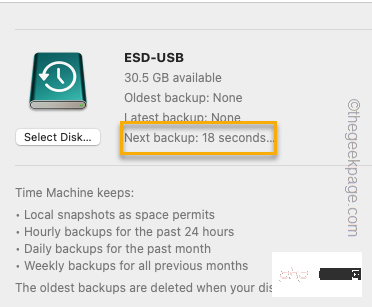
Step 5 –You can easily see the status of the backup process if you look at the Time Machine screen. Depending on the files and applications you have, this process may take longer.
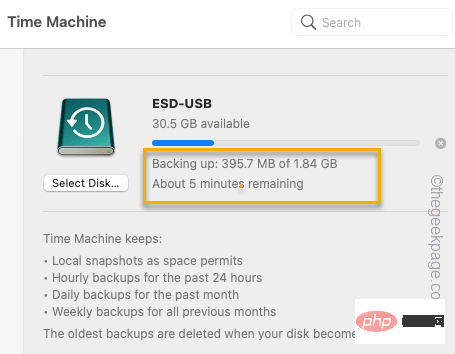
Once the backup process is completed, you will see the following message in the notification –
Time Machine has finished the first backup to
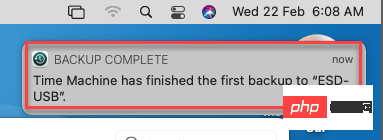
In this way, you can Create backups easily with Time Machine.
*Note –
If your drive is not empty, Time Machine will prompt you to erase all data on the drive.
So, you can just click "Erase" to completely erase the drive and start the process.
Automated backup process
You can set up Time Machine as an automatic backup system.
Step 1 –On your Mac, click the “Apple” icon. Now, click on “System Settings” to open it.
[In older generation Mac devices, this same setting is called "System Preferences".

Step 2 –Look for the “Time Machine” application. You can find it at the bottom of the menu. Click it. A

Step 3 –When Time Machine opens, make sure you have “Automatic Backup” checked.
You can now close the Time Machine tab. It will now handle backup situations automatically. Typically, it creates system snapshots on a daily basis.
Method 2 – Back up Mac using iCloud
You can use iCloud space to back up Mac devices. This cloning feature is one of the convenient features of iCloud. You can use this clone to easily recreate your system image when you need it.
Step 1 –Click the spotlight icon or press the command space bar to open the spotlight.
or press the command space bar to open the spotlight.
Step 2 –Then, type “云” in the search bar.
Step 3 –Now, click on “iCloud Drive” to open it.
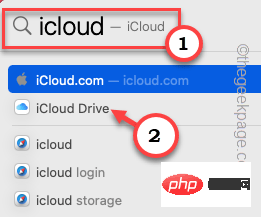
Step 4 –If you haven’t allowed iCloud storage yet, it will show a prompt to allow it to use iCloud Drive.
Step 5 –Just click on “Open Apple ID Preferences...” to open it.

If you have not yet used/created an Apple ID to log in to your Mac device, please do so first.
Step 6 –After logging in with your Apple ID, just make sure the “iCloud Drive” option is selected.
It takes some time for your Mac to read iCloud Drive.
Step 7 –Now, click on “Options…” to open the other Options page.
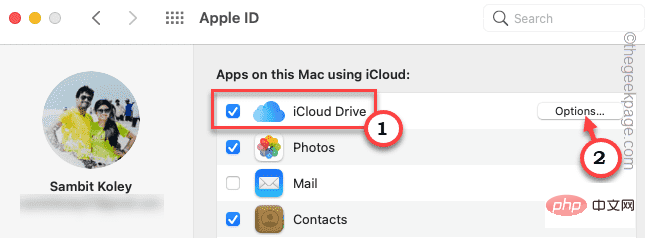
Step 8 –Here you will see a list of applications that can store data on the cloud. So make sure you check the absolutely necessary items such as Desktop Folders, Pages, System Preferences etc.
Step 9 –Click “Finish” to save the settings.
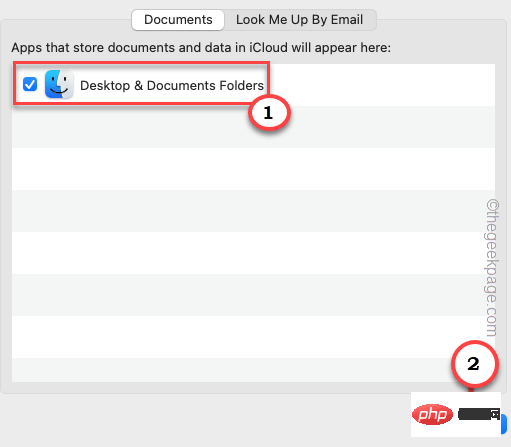
Note - iCloud space is only free to use up to 5GB, which is very small. However, you can easily increase this storage limit with a paid Apple icloud service. Here we have listed the prices below to give you a better understanding – UK: 79p (50GB), £2.49 (200GB), £6.99 (2TB)
- US: 99c (50GB), $2.99 (200GB), $9.99 (2TB)
- EURO: 99c (50GB), €2.99 (200GB), €9.99 (2TB)
- INDIA – ₹75 (50GB), ₹219 (200GB), ₹749 (2TB)
- All rates mentioned here are as of 23rd March w.r.t conversion rates and pricing. You will get the latest information from icloud plans.
There are paid cloud drives such as Dropbox, Google Drive, and Microsoft OneDrive that you can use to back up your Mac’s data. However, unlike Time Machine or iCloud, it is not easy to restore your Mac device using this backup. In short, you have to set up the backup yourself. You know how these cloud solutions work on any device, they work on Mac too.
Way 4 – Using Web-Based Backup
The last one lets you use a web-based backup solution like Carbonite. It will create a backup of your Mac over the internet and store it in its servers. If needed, you can use the application to restore your system from an image stored on the server. Not only is this a great solution for individual users, organizations can safely create backups of their systems.
The above is the detailed content of How to back up your Mac. For more information, please follow other related articles on the PHP Chinese website!

Hot AI Tools

Undresser.AI Undress
AI-powered app for creating realistic nude photos

AI Clothes Remover
Online AI tool for removing clothes from photos.

Undress AI Tool
Undress images for free

Clothoff.io
AI clothes remover

AI Hentai Generator
Generate AI Hentai for free.

Hot Article

Hot Tools

Notepad++7.3.1
Easy-to-use and free code editor

SublimeText3 Chinese version
Chinese version, very easy to use

Zend Studio 13.0.1
Powerful PHP integrated development environment

Dreamweaver CS6
Visual web development tools

SublimeText3 Mac version
God-level code editing software (SublimeText3)

Hot Topics
 deepseek ios version download and installation tutorial
Feb 19, 2025 pm 04:00 PM
deepseek ios version download and installation tutorial
Feb 19, 2025 pm 04:00 PM
DeepSeek Smart AI Tool Download and Installation Guide (Apple Users) DeepSeek is a powerful AI tool. This article will guide Apple users how to download and install it. 1. Download and install steps: Open the AppStore app store and enter "DeepSeek" in the search bar. Carefully check the application name and developer information to ensure the correct version is downloaded. Click the "Get" button on the application details page. The first download may require AppleID password verification. After the download is completed, you can open it directly. 2. Registration process: Find the login/registration portal in the DeepSeek application. It is recommended to register with a mobile phone number. Enter your mobile phone number and receive the verification code. Check the user agreement,
 Why can't the Bybit exchange link be directly downloaded and installed?
Feb 21, 2025 pm 10:57 PM
Why can't the Bybit exchange link be directly downloaded and installed?
Feb 21, 2025 pm 10:57 PM
Why can’t the Bybit exchange link be directly downloaded and installed? Bybit is a cryptocurrency exchange that provides trading services to users. The exchange's mobile apps cannot be downloaded directly through AppStore or GooglePlay for the following reasons: 1. App Store policy restricts Apple and Google from having strict requirements on the types of applications allowed in the app store. Cryptocurrency exchange applications often do not meet these requirements because they involve financial services and require specific regulations and security standards. 2. Laws and regulations Compliance In many countries, activities related to cryptocurrency transactions are regulated or restricted. To comply with these regulations, Bybit Application can only be used through official websites or other authorized channels
 Sesame Open Door Trading Platform Download Mobile Version Gateio Trading Platform Download Address
Feb 28, 2025 am 10:51 AM
Sesame Open Door Trading Platform Download Mobile Version Gateio Trading Platform Download Address
Feb 28, 2025 am 10:51 AM
It is crucial to choose a formal channel to download the app and ensure the safety of your account.
 How to enable Douyin's beanbao function
Nov 28, 2024 pm 07:39 PM
How to enable Douyin's beanbao function
Nov 28, 2024 pm 07:39 PM
The AI assistant "Doubao" launched by ByteDance, the parent company of TikTok, has attracted attention for its powerful generation capabilities. This guide provides simple steps to help you start your bean bag journey with ease. You can log in to Doubao through the web version (doubao.com) or Android App. You need to use your Douyin account for the first time. After logging in, you can try functions such as text creation, image generation, and voice interaction (Android App only) to explore the fun of AI creation.
 gate.io sesame door download Chinese tutorial
Feb 28, 2025 am 10:54 AM
gate.io sesame door download Chinese tutorial
Feb 28, 2025 am 10:54 AM
This article will guide you in detail how to access the official website of Gate.io, switch Chinese language, register or log in to your account, as well as optional mobile app download and use procedures, helping you easily get started with the Gate.io exchange. For more tutorials on using Gate.io in Chinese, please continue reading.
 How to find the download link of Ouyi okx Android and Apple
Feb 21, 2025 pm 05:39 PM
How to find the download link of Ouyi okx Android and Apple
Feb 21, 2025 pm 05:39 PM
Ouyi OKX is a world-leading cryptocurrency exchange that provides users with a safe and convenient trading experience. Users can download Ouyi OKX's mobile apps, including Android and Apple versions through official channels.
 Sesame Open Door Exchange App Official Download Sesame Open Door Exchange Official Download
Mar 04, 2025 pm 11:54 PM
Sesame Open Door Exchange App Official Download Sesame Open Door Exchange Official Download
Mar 04, 2025 pm 11:54 PM
The official download steps of the Sesame Open Exchange app cover the Android and iOS system download process, as well as common problems solutions, helping you download safely and quickly and enable convenient transactions of cryptocurrencies.
 How to install and register an app for buying virtual coins?
Feb 21, 2025 pm 06:00 PM
How to install and register an app for buying virtual coins?
Feb 21, 2025 pm 06:00 PM
Abstract: This article aims to guide users on how to install and register a virtual currency trading application on Apple devices. Apple has strict regulations on virtual currency applications, so users need to take special steps to complete the installation process. This article will elaborate on the steps required, including downloading the application, creating an account, and verifying your identity. Following this article's guide, users can easily set up a virtual currency trading app on their Apple devices and start trading.





